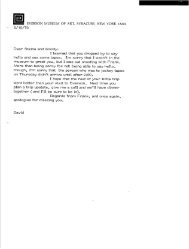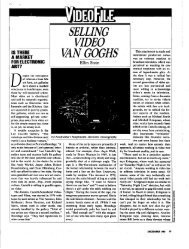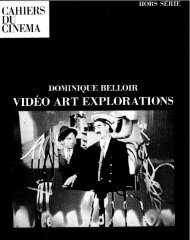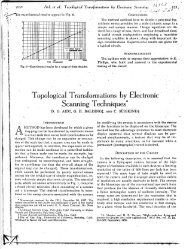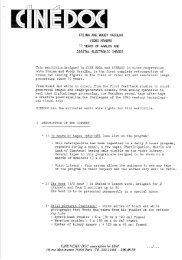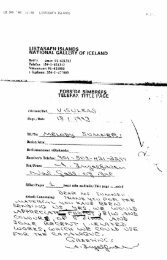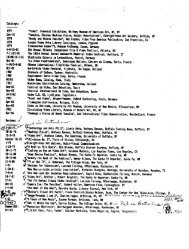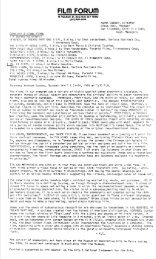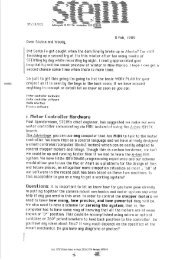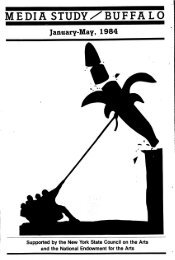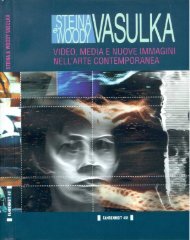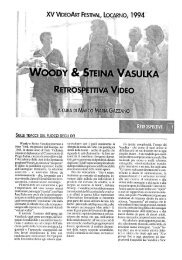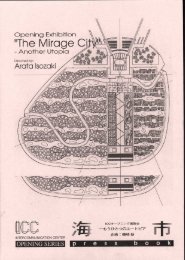Chapter 4: A HISTORY OF COMPUTER ANIMATION ... - Vasulka.org
Chapter 4: A HISTORY OF COMPUTER ANIMATION ... - Vasulka.org
Chapter 4: A HISTORY OF COMPUTER ANIMATION ... - Vasulka.org
Create successful ePaper yourself
Turn your PDF publications into a flip-book with our unique Google optimized e-Paper software.
<strong>Chapter</strong> 4 : A <strong>HISTORY</strong> <strong>OF</strong> <strong>COMPUTER</strong> <strong>ANIMATION</strong> 3/20/92 46<br />
The perfection of this technology coincides with the first<br />
generation of computer animation companies-MAGI, Robert Able<br />
Associates (with Bill Kovacks), III, and Digital Effects (founded by<br />
Judson Rosebush, Donald Leich, and Jeffrey Kleiser), who all end up<br />
working together on TRON, the first feature film with a major<br />
computer animation component .<br />
In 198?, a new generation of raster non-programmable film<br />
recorders from companies such as Dunn, Matrix and Management<br />
Graphics plummeted prices and simplified operations . The new<br />
generation of raster recorders, coupled with the personal computer,<br />
exploded the color slide presentation and business graphics<br />
marketplace . And hooking a 35mm pin registered Acme or Mitchell<br />
camera onto one of these units only required the skill of a good<br />
machines, a tactic taken by newer generation companies, like<br />
Intelligent Light . Computer animation remained difficult, but the<br />
financial and technical hurdles that needed to be overcome were<br />
vastly diminished .<br />
Image Digitizing<br />
The digitization of 2D images is actually quite old ; early<br />
examples probably predate the Bartlane transatlantic cable (1921) .<br />
These early systems represent the image as a matrix of numbers<br />
representing the intensity values at each pixel, and a TTY style<br />
output device reproduces the image using either special characters<br />
or alphanumeric overstrikes .<br />
Adding a computer provides a better way to not only store and<br />
transmit pictures, but also to analyze them . A rotary drum scanners<br />
which could digitize individual images was built by Roland Kirsch at<br />
the National Bureau of Standards (1957), and in 1964 the Jet<br />
Propulsion Lab in California used pixel matrices to represent<br />
television pictures from the Ranger Moon probe . Using frequency<br />
domain techniques the pictures were computationally enhanced to<br />
make them look better and reduce interplanetary noise . Again Bell<br />
Labs demonstrated a wide range of applications, including using half<br />
toning techniques to make dot patterns on the SC-4020 film<br />
recorder (1966) . Digitizing film and tape proved to be a more<br />
formidable task, although single digitized images began to be<br />
employed in computer animations as image maps after 19xx .<br />
The first practical machine to capture a sequence of film<br />
images in registration was the above mentioned III film recorder,<br />
built for the motion picture group (1976?), and which worked as a<br />
flying spot scanner with a digitizer coupled to the output of the<br />
photometer behind the film plane (figure ??) . The III machines saw



